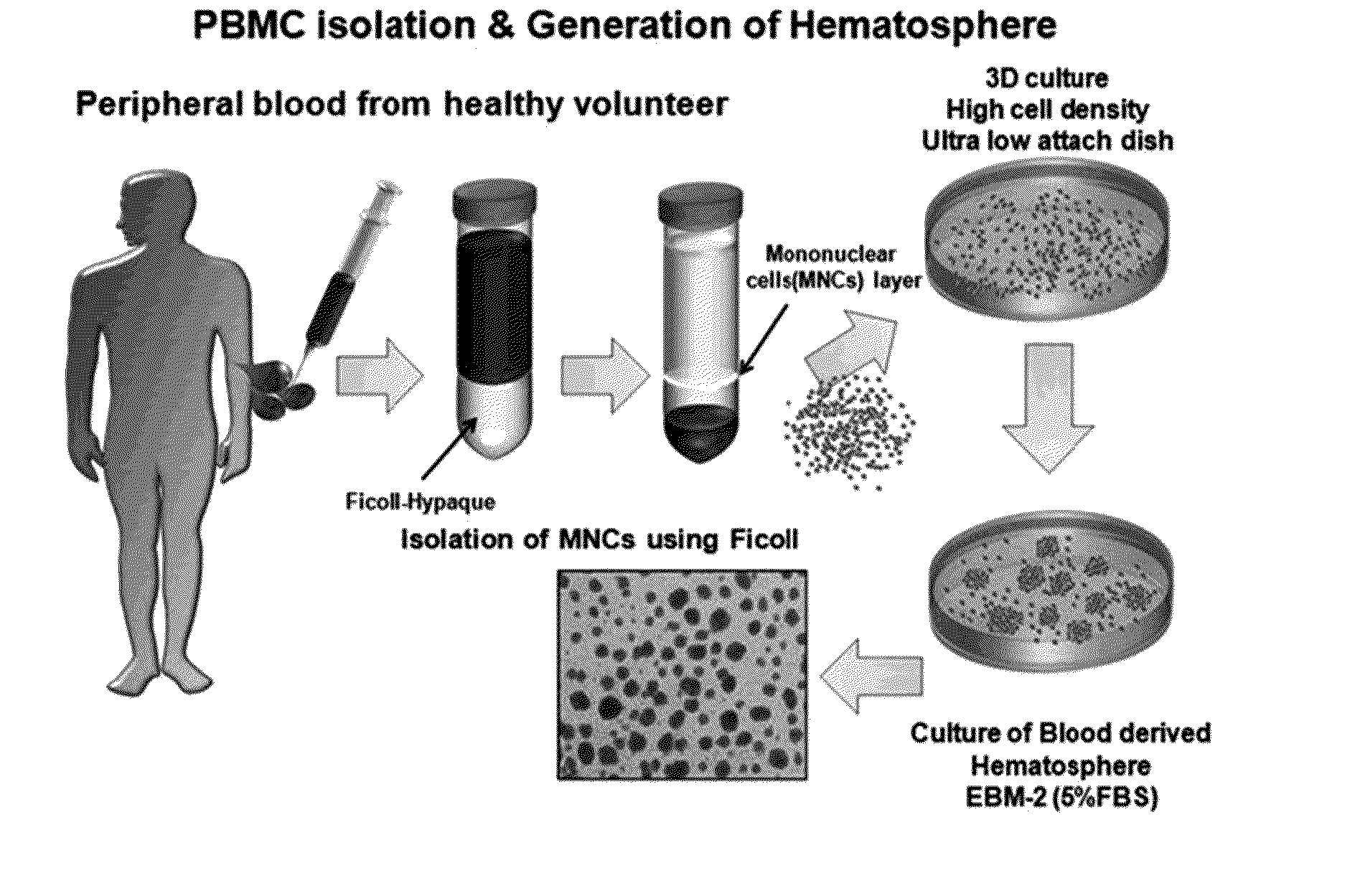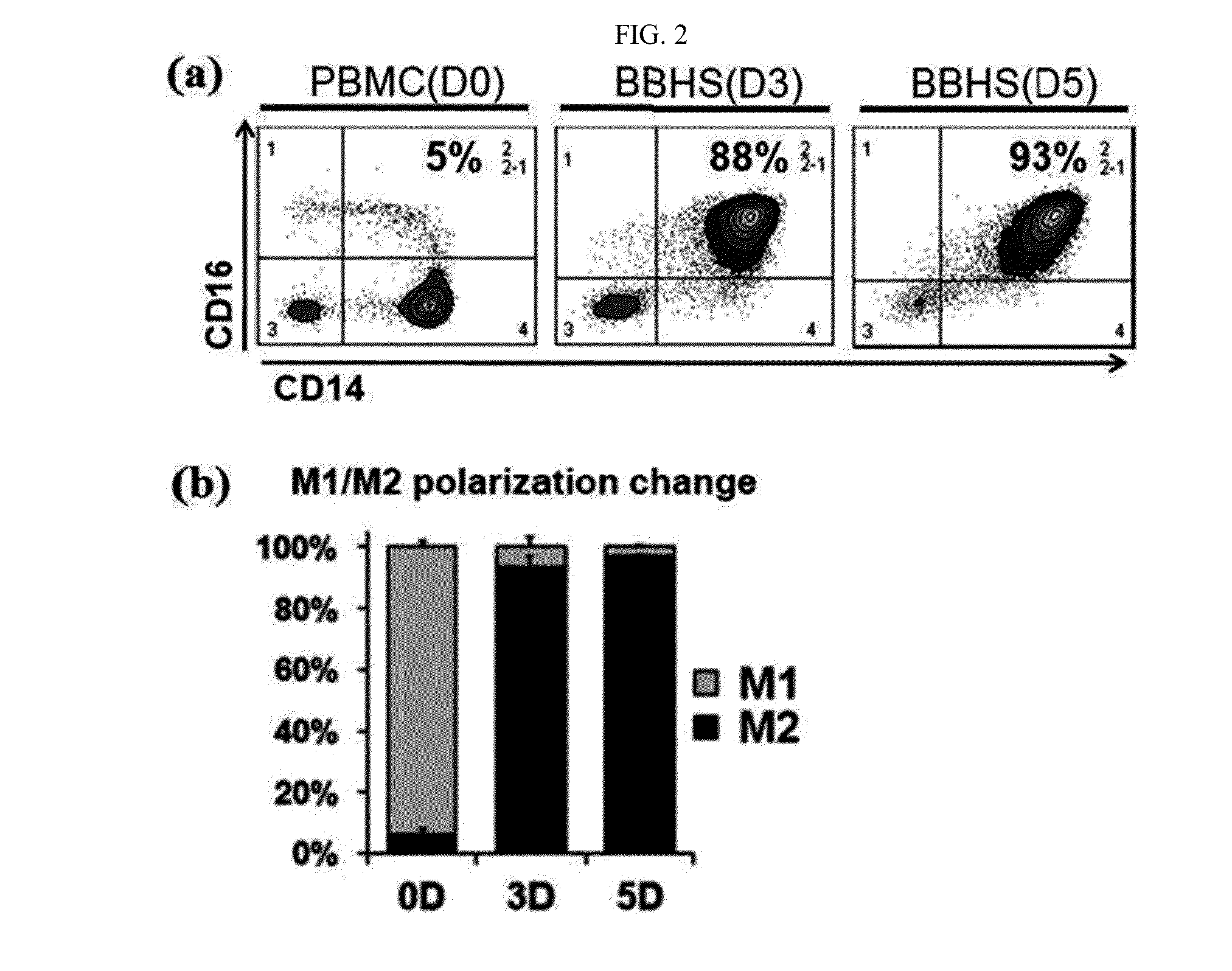Pharmaceutical Composition Comprising Human-Blood-Derived-Cell Mass
- Summary
- Abstract
- Description
- Claims
- Application Information
AI Technical Summary
Benefits of technology
Problems solved by technology
Method used
Image
Examples
example 1
Example
Generation of Blood-Born Hematospheres (BBHSs)
[0130](1) Step of Isolating Monocyte Cells from Peripheral Blood
[0131]Peripheral blood was obtained using a heparin (about 100 ul)-coated 50 ml syringe. 10 ml of the peripheral blood was input to a 50 ml tube. 30 ml of a phosphate-buffered saline (PBS) was added thereto and carefully mixed. 10 ml of Ficoll applied to the diluted blood to express a density gradient was slowly added into the bottom of the tube using a pipet aid. A transparent Ficoll layer and a red blood layer were separated and then centrifuged at 2,500 rpm and 25° C. for 30 minutes with a minimum stop rate. A yellow serum layer, a white monocyte layer, and a transparent Ficoll layer were isolated in an upper portion and a red layer of red blood cells and a polynuclear layer were isolated in a bottom portion. After isolation was confirmed, the yellow serum layer at an upper portion was taken out and then the white monocyte layer was carefully transferred to a new ...
example < 1.2
Example
Step of Determining Increase in Anti-Inflammatory Monocytes
[0136]Peripheral blood mononuclear cells (PBMCs) and blood-born hematospheres (BBHSs) generated according to the present invention were cultured for 3 days and 5 days. Then, only hematospheres were selected to determine a change in anti-inflammatory monocytes through a FACS technique. In general, CD14(+)CD16(−) is known as a marker of inflammatory monocytes (M1), and CD14(+)CD16(+) is known as a marker of anti-inflammatory monocytes (M2). Inflammatory monocytes (M1) and anti-inflammatory monocytes (M2) were analyzed using the markers. FIG. 2 shows the results.
[0137]Most peripheral blood mononuclear cells initially are the inflammatory monocytes (M1). The anti-flammatory monocytes (M2) are included in a small amount of about 5%. However, as shown in FIG. 2, it can be seen that the number of anti-inflammatory monocytes significantly increased when hematospheres (BBHSs) were cultured for 3 days and 5 days. In addition, ...
example < 1.3
Example
Determination Expression of Anti-Inflammatory-Related Genes and Increase in Cytokine Secretion
[0138]In FIG. 3, RNA was extracted from peripheral blood mononuclear cells (PBMCs) and hematospheres (BBHSs) obtained in Example , and then RT-PCR was performed to identify expression of anti-inflammatory-related genes. FIG. 3 shows the results.
[0139]As results, as shown in FIG. 3, hematospheres (BBHSs) showed significantly increased expression of Interleukin-4 (IL-4), IL-6, IL-10, IL-13, the transforming growth factor beta 1 (TGF-beta1), IL-1RA, Syk, and MCP-1 than peripheral blood mononuclear cells (PBMCs, OD). For hematospheres, it was determined that the expression further increased when the culture was performed for 5 days (5D) than when the culture was performed for 3 days (3D).
[0140]In addition, a group in which hematospheres (BBHSs) obtained in Example and PBMCs were attached was cultured for 5 days. Specifically, supernatants of suspension (3D) culture and attached (2D) cu...
PUM
 Login to View More
Login to View More Abstract
Description
Claims
Application Information
 Login to View More
Login to View More - R&D
- Intellectual Property
- Life Sciences
- Materials
- Tech Scout
- Unparalleled Data Quality
- Higher Quality Content
- 60% Fewer Hallucinations
Browse by: Latest US Patents, China's latest patents, Technical Efficacy Thesaurus, Application Domain, Technology Topic, Popular Technical Reports.
© 2025 PatSnap. All rights reserved.Legal|Privacy policy|Modern Slavery Act Transparency Statement|Sitemap|About US| Contact US: help@patsnap.com



